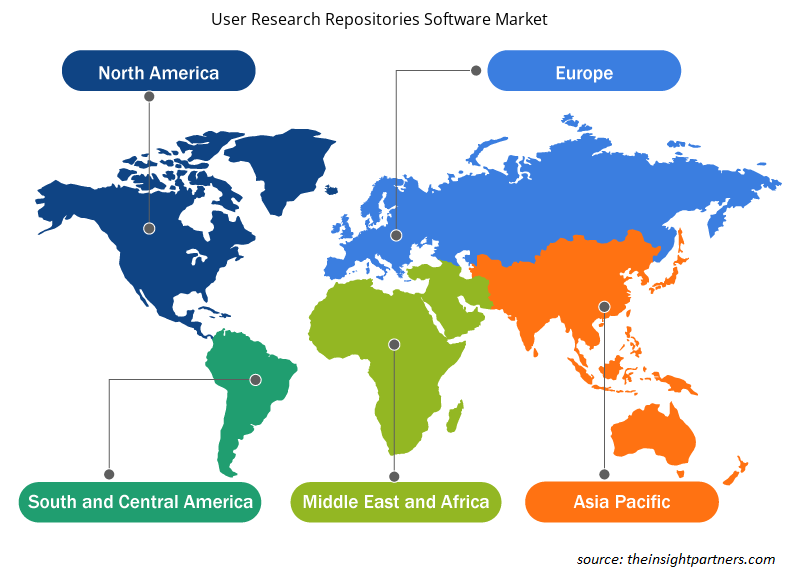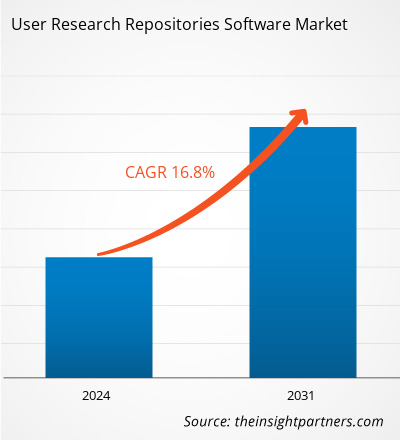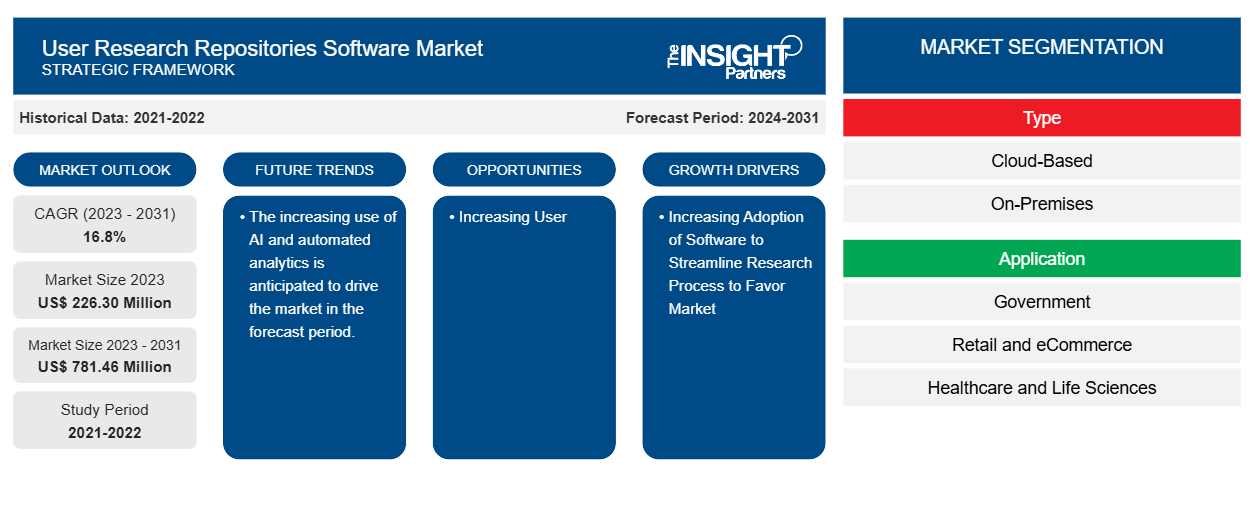Se prevé que el tamaño del mercado de software de repositorios de investigación de usuarios alcance los 781,46 millones de dólares en 2031, frente a los 226,30 millones de dólares en 2023. Se espera que el mercado registre una CAGR del 16,8 % durante el período 2023-2031. La creciente adopción de software para agilizar el proceso de investigación y la creciente demanda de las empresas emergentes de tecnología UX probablemente sean los impulsores y las tendencias clave del mercado.
Análisis del mercado de software de repositorios de investigación de usuarios
El crecimiento del mercado de software de repositorios de investigación de usuarios se atribuye a la creciente adopción de software para optimizar el proceso de investigación y a la creciente demanda de las empresas emergentes de tecnología UX. Además, el aumento de los datos de experiencia digital de los usuarios y el uso de inteligencia artificial y análisis son otros factores que impulsan el crecimiento del mercado de software de gestión de promociones comerciales.
Descripción general del mercado de software de repositorios de investigación de usuarios
Un repositorio de investigación de usuarios es una base de datos centralizada que incluye todos los datos de investigación de usuarios, informes de investigación de UX y artefactos. Diferentes equipos (como diseño, producto, ventas y marketing) pueden encontrar información de proyectos anteriores para contextualizar los escenarios actuales y tomar decisiones informadas.
Personalice este informe según sus necesidades
Obtendrá personalización en cualquier informe, sin cargo, incluidas partes de este informe o análisis a nivel de país, paquete de datos de Excel, así como también grandes ofertas y descuentos para empresas emergentes y universidades.
-
Obtenga las principales tendencias clave del mercado de este informe.Esta muestra GRATUITA incluirá análisis de datos, desde tendencias del mercado hasta estimaciones y pronósticos.
Repositorios de investigación de usuarios: impulsores y oportunidades del mercado de software
Aumento de la adopción de software para optimizar el proceso de investigación en beneficio del mercado
El software de repositorio de investigación puede mejorar enormemente la eficiencia al organizar los datos, optimizar los flujos de trabajo y reducir el tiempo dedicado a las tareas manuales. Esto hace que el proceso de investigación sea más rápido y productivo. Además, a medida que aumenta el volumen de datos de investigación, la necesidad de soluciones de gestión de datos eficaces se vuelve crítica. El software de repositorio de investigación ayuda a almacenar, organizar y recuperar grandes volúmenes de datos fácilmente.
Mejorando la experiencia digital del usuario.
A medida que las experiencias digitales se vuelven más complejas y personalizadas, las organizaciones necesitan conocer mejor el comportamiento y las preferencias de los usuarios. Los repositorios de investigación de usuarios ayudan a consolidar y analizar estos datos de manera eficaz. Las empresas que priorizan la experiencia del usuario obtienen una ventaja competitiva. Invertir en repositorios de investigación de usuarios permite una mejora continua de los productos digitales, lo que conduce a una mayor satisfacción y lealtad del usuario. Además, al centrarse en la experiencia del usuario, las decisiones se basan cada vez más en los datos. Los repositorios de investigación de usuarios proporcionan una ubicación centralizada para almacenar y acceder a los datos de investigación de usuarios, lo que facilita una toma de decisiones más informada.
Informe de mercado de software de repositorios de investigación de usuarios Análisis de segmentación
Los segmentos clave que contribuyeron a la derivación del análisis del mercado de software de repositorios de investigación de usuarios son el tipo y la aplicación.
- Según el tipo, el mercado de software de repositorios de investigación de usuarios se divide en basado en la nube y local. Se prevé que el segmento basado en la nube tenga una participación de mercado significativa en el período de pronóstico.
- Según la aplicación, el mercado de software de repositorios de investigación de usuarios se divide en gobierno, comercio minorista y comercio electrónico, atención médica y ciencias biológicas, BFSI, transporte y logística, telecomunicaciones y TI, fabricación y otros. Se prevé que el segmento gubernamental tenga una participación de mercado significativa en el período de pronóstico.BFSI, transportation and logistics, telecom and IT, manufacturing, and others. The government segment is anticipated to hold a significant market share in the forecast period.
Análisis de la cuota de mercado de software de repositorios de investigación de usuarios por geografía
El alcance geográfico del informe de mercado de software de repositorios de investigación de usuarios se divide principalmente en cinco regiones: América del Norte, Asia Pacífico, Europa, Medio Oriente y África, y América del Sur y Central.
América del Norte ha dominado el mercado de software de repositorios de investigación de usuarios. Las tendencias de adopción de alta tecnología en varias industrias en la región de América del Norte han impulsado el crecimiento del mercado de software de repositorios de investigación de usuarios. Se espera que factores como la mayor adopción de herramientas digitales y el alto gasto tecnológico por parte de las agencias gubernamentales impulsen el crecimiento del mercado de software de repositorios de investigación de usuarios de América del Norte. Además, un fuerte énfasis en la investigación y el desarrollo en las economías desarrolladas de los EE. UU. y Canadá está obligando a los actores norteamericanos a traer soluciones tecnológicamente avanzadas al mercado. Además, EE. UU. tiene una gran cantidad de actores del mercado de software de repositorios de investigación de usuarios que se han centrado cada vez más en el desarrollo de soluciones innovadoras. Todos estos factores contribuyen al crecimiento del mercado de software de repositorios de investigación de usuarios de la región .fuelled the growth of the user research repositories software market. Factors such as increased adoption of digital tools and high technological spending by government agencies are expected to drive the North American user research repositories software market growth. Moreover, a strong emphasis on research and development in the developed economies of the US and Canada is forcing the North American players to bring technologically advanced solutions into the market. In addition, the US has a large number of user research repositories software market players who have been increasingly focusing on developing innovative solutions. All these factors contribute to the region's growth of the user research repositories
Repositorios de investigación de usuarios Mercado de software Perspectivas regionales
Los analistas de Insight Partners explicaron en detalle las tendencias y los factores regionales que influyen en el mercado de software de repositorios de investigación de usuarios durante el período de pronóstico. Esta sección también analiza los segmentos y la geografía del mercado de software de repositorios de investigación de usuarios en América del Norte, Europa, Asia Pacífico, Oriente Medio y África, y América del Sur y Central.

- Obtenga datos regionales específicos para el mercado de software de repositorios de investigación de usuarios
Alcance del informe de mercado de software de repositorios de investigación de usuarios
| Atributo del informe | Detalles |
|---|---|
| Tamaño del mercado en 2023 | US$ 226,30 millones |
| Tamaño del mercado en 2031 | US$ 781,46 millones |
| CAGR global (2023 - 2031) | 16,8% |
| Datos históricos | 2021-2022 |
| Período de pronóstico | 2024-2031 |
| Segmentos cubiertos |
Por tipo
|
| Regiones y países cubiertos |
América del norte
|
| Líderes del mercado y perfiles de empresas clave |
|
Densidad de actores del mercado de software de repositorios de investigación de usuarios: comprensión de su impacto en la dinámica empresarial
El mercado de software de repositorios de investigación de usuarios está creciendo rápidamente, impulsado por la creciente demanda de los usuarios finales debido a factores como la evolución de las preferencias de los consumidores, los avances tecnológicos y una mayor conciencia de los beneficios del producto. A medida que aumenta la demanda, las empresas amplían sus ofertas, innovan para satisfacer las necesidades de los consumidores y aprovechan las tendencias emergentes, lo que impulsa aún más el crecimiento del mercado.
La densidad de actores del mercado se refiere a la distribución de las empresas o firmas que operan dentro de un mercado o industria en particular. Indica cuántos competidores (actores del mercado) están presentes en un espacio de mercado determinado en relación con su tamaño o valor total de mercado.
Las principales empresas que operan en el mercado de software de repositorios de investigación de usuarios son:
- Crayon Bits, LLC
- Soluciones Usertimes GmbH
- Información de Tetra Insights, Inc.
- Tecnología Savio Inc.
- Revelar BM
- Tablero de productos, Inc.
Descargo de responsabilidad : Las empresas enumeradas anteriormente no están clasificadas en ningún orden particular.

- Obtenga una descripción general de los principales actores clave del mercado de software de repositorios de investigación de usuarios
Repositorios de investigación de usuarios Noticias del mercado de software y desarrollos recientes
El mercado de software de repositorios de investigación de usuarios se evalúa mediante la recopilación de datos cualitativos y cuantitativos posteriores a la investigación primaria y secundaria, que incluye publicaciones corporativas importantes, datos de asociaciones y bases de datos. A continuación, se enumeran algunos de los desarrollos en el mercado de software de repositorios de investigación de usuarios:
- Tetra Insights, una plataforma de operaciones de investigación con sede en Boulder, tiene como objetivo ayudar a las empresas a alinear la experiencia del cliente con la estrategia y la ejecución. La empresa anunció el viernes que recaudó una ronda de Serie A de 5 millones de dólares. Access Venture Partners lideró la ronda con la participación adicional de Next Frontier Capital y Active Capital. (Fuente: sitio web de la empresa Tetra Insights con sede en Boulder, agosto de 2021)
Informe de mercado de software de repositorios de investigación de usuarios: cobertura y resultados
El informe “Tamaño y pronóstico del mercado de software de repositorios de investigación de usuarios (2021-2031)” proporciona un análisis detallado del mercado que cubre las siguientes áreas:
- Tamaño del mercado de software de repositorios de investigación de usuarios y pronóstico a nivel global, regional y nacional para todos los segmentos clave del mercado cubiertos bajo el alcance
- Tendencias del mercado de software de repositorios de investigación de usuarios, así como dinámicas del mercado, como impulsores, restricciones y oportunidades clave
- Análisis detallado de las cinco fuerzas de Porter y PEST y FODA
- Análisis del mercado de software de repositorios de investigación de usuarios que abarca las tendencias clave del mercado, el marco global y regional, los principales actores, las regulaciones y los desarrollos recientes del mercado
- Análisis del panorama de la industria y de la competencia que abarca la concentración del mercado, el análisis de mapas de calor, los actores destacados y los desarrollos recientes para el mercado de software de repositorios de investigación de usuarios
- Perfiles detallados de empresas
- Análisis histórico (2 años), año base, pronóstico (7 años) con CAGR
- Análisis PEST y FODA
- Tamaño del mercado, valor/volumen: global, regional y nacional
- Industria y panorama competitivo
- Conjunto de datos de Excel
Informes recientes
Testimonios
Razón para comprar
- Toma de decisiones informada
- Comprensión de la dinámica del mercado
- Análisis competitivo
- Información sobre clientes
- Pronósticos del mercado
- Mitigación de riesgos
- Planificación estratégica
- Justificación de la inversión
- Identificación de mercados emergentes
- Mejora de las estrategias de marketing
- Impulso de la eficiencia operativa
- Alineación con las tendencias regulatorias























 Obtenga una muestra gratuita para - Mercado de software de repositorios de investigación de usuarios
Obtenga una muestra gratuita para - Mercado de software de repositorios de investigación de usuarios